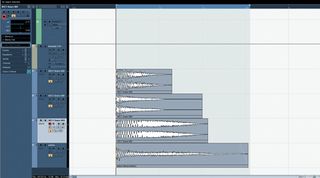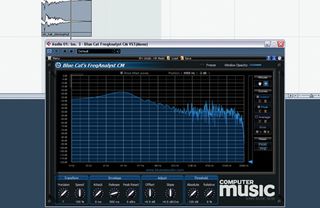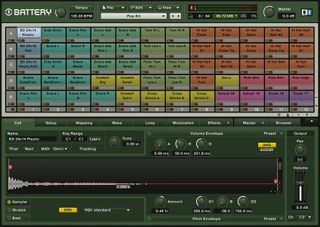Even if you don't use samples anywhere else in your music, it's highly likely that you'll call on them when you're creating your drum tracks.
Simple, static samples have a habit of sounding rather flat, though, and that's not what you want at all. So, here are 18 things you can do to give your drums the wow factor.
1. Think about the high-end
When picking kick drum samples, pay particular attention to the high end of the sound. A hi-hat on top of the kick may feel inconsequential when you're concentrating on finding a sound with a solid attack and bottom end, but it can interfere with the highs of your drum mix later on, which obviously isn't ideal.
2. Layered snares
Getting the ultimate snare sound can be easier if you layer up different samples - this way you don't have to find a single perfect snare sample to do all the work. A good technique is to start with a snare that has a solid bottom end, then fill out the frequency range with other samples.

3. Double snares
If your snare sound has good impact, but lacks room ambience, there is an alternative to simply slapping a reverb on it. If you have another, roomier snare, you can place it after the main hit and use a short fade to bring in the sound.
4. Control the tail
Using amplitude envelopes or fades is a pretty useful technique for tightening up any kind of drum sound. The majority of samplers have simple decay and/or release stages, but some sequencers feature customisable fade-out curves that give you a high level of control over the volume of the drum sample's tail.
5. Shift the pitch
You may find you need to make slight tuning adjustments to certain drum sounds so that they fit in better with the rest of the drum mix or your track overall. Most sequencers use granular pitchshifting to adjust the pitch of notes. If your sequencer enables you to disable pitchshifting, use this option to preserve the quality of your drum samples.

6. Ride the waves
If you're struggling to find a suitable ride sound, you may find that cutting the attack off a cymbal crash, leaving just the tail, creates a workable alternative. If you find the dynamics of this new sound too aggressive, use compression or volume automation to create a smoother sound.
7. Use two hi-hats
Using just a single hi-hat sample can result in an unrealistic-sounding beat. Usually two hi-hats are enough to create a less artificial (or at least funkier) feel. Varying the volume levels of your hits will make them sound more natural and give them their own rhythm.
8. Cut out the quantise
When programming beats from single hits in audio, it's often necessary to turn off your sequencer's automatic quantisation so you can accurately cut the sample at exactly the right spot. You may also find that adjusting the start point of some hits makes them work better with others that are positioned on the same beat.
9. Copy and reverse
To create energy or help fill in any gaps in your beat, create a copy of an open hi-hat or ride and reverse it. Position this before a snare or kick and experiment with the timing and volume level until you've got an effect that you're happy with.
10. Transient attack
If your kick samples don't have enough impact, you might think the best thing to do is beef up the low-end with EQ. However, this will probably just make it sound boomier or muddier. Instead, try sweeping a fairly wide EQ band around the mid and high frequencies - this will bring out the transients more and make the kick punchier.
11. Remove the rumble
When using hi-hat and ride samples, you might find it beneficial to take out any unwanted low end, which just takes up space in the mix. Also, when sampling from vinyl you'll almost certainly have some really low rumble, even if you can't actually hear it in your monitors. A frequency analyser such as FreqAnalyst CM can help identify these rogue frequencies.

12. Turn things down
To bring your kicks out more, try turning down other drums that play at the same time. You could turn down the volume levels of hits that play at the same time, automate their volume level so they swell up as the kick fades, or use sidechain compression.
13. Add some ghosts
Another instance where using two different samples can be better is when programming ghost snares. Ghost snares are quieter snare hits that add some shuffle to the beat, and while you can get away with using the same snare sample for these, employing another sample will make your ghost hits sound much more natural.
14. Export to audio
If you find that you've managed to sculpt a particularly fine drum sound, why not export it as audio? This has several definite advantages: using a bounced down sample means each hit will be perfectly consistent, you save CPU on the effects you would otherwise be using, and you can create a library of your own drum hits that can be used in other projects.
15. Tweak the decay
If you find a loop with a kick drum sound that you like, use a low-pass filter modulated by an envelope to cut out the high frequency sounds after the kick's transient. Experiment with different decay times to see what works best for that particular loop.
16. Tailored EQ
When working with sliced up breakbeats, you might find that different parts of the beat benefit from having different EQ settings. Most samplers are unable to assign different slices to different outputs, and if yours doesn't, bounce the beat to audio, then move slices onto different audio tracks so that they can be processed separately.

17. Shorten it down
You may find that your kick drum has too much low end, which can interfere with your track's bassline. You can take out unwanted bass with a high-pass filter, but that's not the only way to tame the bottom end. Because a kick drum sound descends in pitch, the lowest frequencies are at the end of the sound. By shortening the sample you can cut out these frequencies without filters or EQ. You'll likely find that putting a short fade-out on the end of the kick makes it sound much more natural.
18. Humanise
While using repetitive, consistent drum hits is OK for dance music, if you're trying to get a more realistic, human-sounding drum part and your sampler has a randomised 'round robin' feature, use it to cycle through different drum sounds at random. As long as your drum samples are similar-sounding, this trick will enhance the believability of your drum parts. The more drum samples you use, the more convincing the feel. Subtle timing changes to individual hits can enhance the effect.

